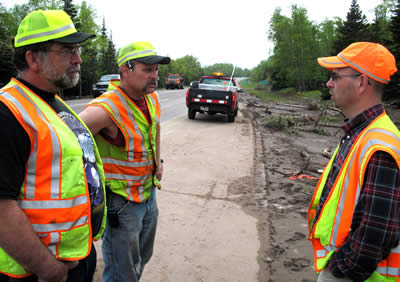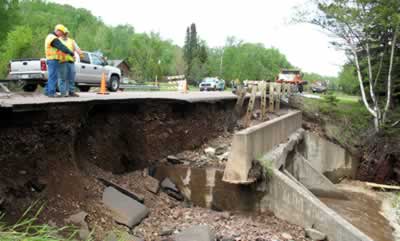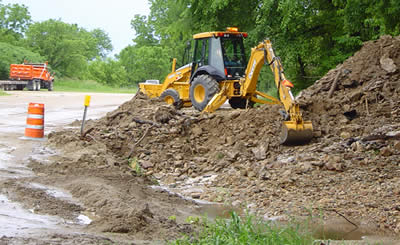|
By Craig Wilkins

The level of damage to culvert structures along Hwy 61 in Cook County proved to be a challenge for the District 1 bridge crew. LeRoy Cronin (left) and Dow Rychlak review repair options with Pat Huston, District 1 bridge engineer. Photo by John Bray |
Near Fergus Falls, intense wind bursts blew two semitrailers over on Interstate 94 June 10, forcing the State Patrol to close a section of the freeway for several hours until the trucks were cleared away.
The trucks, both unloaded, were heading in opposite directions when they were toppled by gale-force winds.
In Morgan, a grain elevator fire adjacent to Hwy 67’s right of way required officials to close the road in the Redwood County city for nearly two days.
The highway was initially closed because it was filled with firefighters and their equipment.
The detour was lifted when fire marshals determined the elevator’s burned-out hulk was not in danger of falling onto the roadway.
But the main road-closing factor was flooding.
Throughout the state, floodwaters washed out shoulders, undercut roadbeds, snarled traffic and disrupted everyday life and commerce.
High waters caused scattered road closures in northern and northwestern Minnesota.
Some road sections such as Hwy 28 near Graceville had water covering the roadway, requiring District 4 crews to flag motorists through the area until the water receded.
Flooding was much more severe in other regions.
Water from heavy rains moved across saturated soils in many location, gouging new channels and flooding farm fields and highways.
The city of Austin experienced widespread flooding from the Cedar River. District 6 closed I-90 between Albert Lea and Hwy 56 east of Austin. District officials also closed Hwy 105 from Austin to the Iowa border.
However, the state’s northeastern and southeastern regions bore the brunt of recent floods.

Duane Hill (left) and Steve Baublitz survey the massive damage to the roadway shoulder and the easterly headwall of a large culvert that drains the Devil's Track River into Lake Superior north of Grand Marais.
Photo by John Bray |
Floods batter scenic Hwy 61 near Grand Marais
In northeastern Minnesota, the Devil Track River washed out part of Hwy 61 north of Grand Marais. The river’s explosive energy and volume overwhelmed a culvert that carries it into Lake Superior.
Both the culvert and the roadway sustained extensive damage. Streets in downtown Grand Marais were flooded as well.
Further south on Hwy 61, Lutsen Creek flooded near Lutsen, causing major damage to the roadway.
Floodwaters also damaged culverts and driveway entrances for 10 miles between Grand Marais and Lutsen.
Duane Hill, District 1 assistant district engineer for operations, said crews have repaired nearly all of the major damage.
Mudslides, flash floods plague southeastern Minnesota
In a scenario reminiscent of last August’s devastating floods, two rainstorms three days apart lingered over the region, dropping as much as 10 inches of water on already saturated ground. The downpours triggered mudslides in some areas and widespread flooding.
Hwy 26 near Reno in Houston County was one road hit hard by the mudslides.
“On Saturday when this bluff kind of eroded and slid down, the road was entirely covered,” Scott Dolle, a transportation generalist at the La Crescent truck station reported to KAAL-TV in Austin.
“On Sunday we were down here with the big plows and pushed the mud and debris and trees off the road,” he said.
Tolle and his coworkers in District 6 kept at it, cleaning ditches and clearing culverts to prevent future back-ups and repairing damaged highways.

District 6 crews use a backhoe to remove mud, debris and trees from Hwy 26 near Reno in Houston County. Photo by David Redig |
“We had several sections of highways closed or damaged from the June 12 storm that we had to close again because of the storms that hit a few days later,” said Dave Redig, District 6 east area maintenance superintendent.
“The damage was miniscule compared with last year, but last year’s flood stripped many hills and bluffs of their vegetation, making them even more prone to mudslides,” he said.
Redig added that, in places, the June storms damaged road repairs made after last year’s devastation. Some of the repairs, he said, were just completed this spring.
Redig said the district also had a washout on Hwy 61 in Homer, just south of Winona.
“District employees showed a lot of resilience dealing with the results of two storms and the temporary closing of the Hwy 43 bridge in Winona,” he said.
Steve Lund, state maintenance engineer, said he was pleased but not surprised by the responsiveness of employees to the flooding.
“The maintenance employees—all Mn/DOT employees, actually—demonstrated an ability to rise to the level required by emergency situations,” he said.
Lund noted that the most severe flooding occurred in districts already involved in repairing major bridges and managing related traffic disruptions.
“Mn/DOT people are versatile,” he said, “able to switch their focus quickly in a crisis and then return just as quickly to business as usual.”
|



